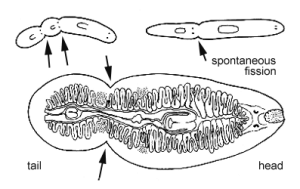-
The two-headed worm from space.
-
Here's a closer look at old Two-Head. You can see both its heads look pretty good.Tufts University
-
The astronaut worms after they returned from space. Note that they are curled up and paralyzed here. It took them a couple of hours to recover and start swimming again.
Among the hundreds of scientific tests happening on the International Space Station, only one has yielded a result worthy of a B-movie starring Ice Cube. It turns out that flatworms undergo an odd and as-yet-unexplained transformation in space. When profoundly injured, they grow a second head.
Scientists who study tissue regeneration have long been fascinated by flatworms because of the worms' ability to regrow after being cut in half. The worms can even regrow heads. But as Tufts University biology researcher Junji Morokuma and his colleagues explain in a paper for the journal Regeneration, they have never seen a worm grow two heads after amputation. But that's just what happened when an amputated flatworm was sent to the ISS back in January 2015.
Delivered to the ISS via SpaceX Commercial Resupply Service Mission 5, the two-header was just one of several flatworms kept aboard for a five-week experiment. Some were whole, and others were amputated. The point, as Tufts University biologist Michael Levin put it in a release, was to study how the environment would affect tissue regeneration.
"During regeneration, development, and cancer suppression, body patterning is subject to the influence of physical forces, such as electric fields, magnetic fields, electromagnetic fields, and other biophysical factors," he explained.
Learning about how flatworms deal with space injuries could affect wound care among humans, too. "As humans transition toward becoming a space-faring species, it is important that we deduce the impact of space flight on regenerative health for the sake of medicine and the future of space laboratory research," said Morokuma.

Meanwhile, the uninjured space worms among its cohort underwent what's called "spontaneous fission," meaning they split apart into two worms. This is a form of asexual reproduction where the original worm grows a second worm attached to its tail, Human Centipede-style, and eventually the new worm splits off. The researchers say that the spontaneous fission may have been caused by temperature fluctuations, so they're not assuming it was a result of life in space.
When the worms returned to Earth, Morokuma and his colleagues spent 20 months comparing them with a control group of worms who had been kept in the lab. The lab worms had been in the same kinds of water tubes, in the same environment, with one obvious difference: no outer space.
The researchers noticed right away that the space worms had a difficult time adjusting to Earth again. For a couple of hours, they were curled up and paralyzed. But then they began to swim normally again.
"This indicates that [the worms] modified their biological state to accommodate the environmental change; when reintroduced to fresh water, the environmental change back to standard living conditions resulted in severe shock because of their altered metabolic state," write the researchers in their paper.
As for the two-headed worm, it stubbornly refused to go back to a one-headed lifestyle. When researchers cut off both its heads, it regrew them. Space had permanently altered this flatworm's body plan. More research is needed to figure out why.
Previous studies have focused on these animals' astonishing ability to regrow their heads. One of the most incredible parts of this process is that sometimes the worm regrows its head from what was previously its tail. And that means it has to re-route its "excretory system," known colloquially as the poop chute.
"The excretory system, consisting of units called protonephridia, must be restored in order to resume metabolic waste removal and osmoregulation," note Max Planck Institute biomedical researchers Kerstin Bartscherer and Suthira Owlarn in the journal Regeneration. They also describe which genes seem to govern where the worm will regrow its new head.
Luckily, flatworms keep their mouths roughly in the center of their bodies, and they excrete waste through countless pores. So it's not as if these worms are actually growing heads out of their butts. I know that's disappointing for the eight-year-old comedians in all of us, but at least we've got two-headed space worms.
Regeneration, 2017. DOI: 10.1002/reg2.79 (About DOIs).
Listing image by Tufts University
reader comments
43